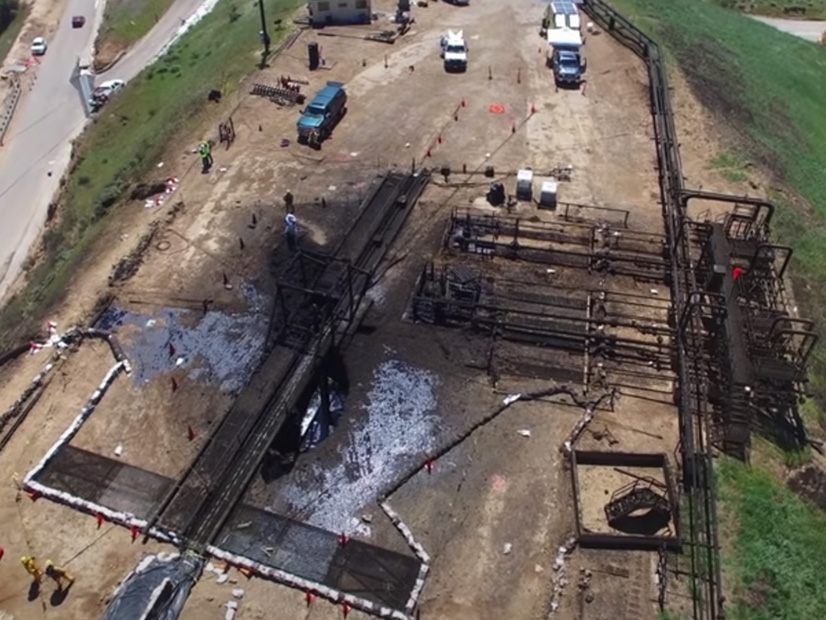
Concerned about a shortage of natural gas this winter, the California Public Utilities Commission on Thursday made the controversial decision to increase the maximum amount of gas stored at the troubled Aliso Canyon underground facility by more than 7 billion cubic feet.
The unanimous decision came after nearly two hours of public testimony, much of it emotional, from residents who live near the site of one of the worst methane leaks in U.S. history. From October 2015 to February 2016, a ruptured pipe at the SS-25 well spewed more than 100,000 tons of natural gas into the atmosphere, leading to a blowout. The leak was contained after four months and multiple failed attempts.
“My family and I still suffer daily from the physical and mental health effects of the Aliso Canyon blowout,” Dan Labudas, a resident of the adjacent Porter Ranch community, told the commissioners. “Back in 2015, when the leak occurred, we suffered from nosebleeds, stomach aches, headaches, nausea and other physical and mental ailments. The four months it took to seal the leak were some of the most stressful and devastating months for my family and community.”
The ailments Labudas described were common to many residents living near the facility. In late September, SoCalGas and its parent company Sempra Energy agreed to pay $1.8 billion to settle the claims of 35,000 victims of the leak.
Labudas on Thursday urged the CPUC to deny any increase in storage limits and to shut down Southern California Gas Co.’s sprawling underground facility, a main gas supply for the Los Angeles Basin.
The CPUC’s original proposed decision called for increasing Aliso Canyon’s storage limits from 34 billion cubic feet to nearly 69 billion cubic feet. Commissioner Martha Guzman Aceves offered an alternative that would allow an increase to just over 41 billion cubic feet, enough to ensure reliability this winter for ratepayers in Southern California, she said.
The decision is “very limited to the winter interim storage levels,” Guzman Aceves said.
Unpredictable weather and a strained gas supply this year made the measure necessary, she said.
“For a good year-and-a-half now, we have seen the very high fluctuations in our changing climate that many of us thought would be unlikely in the past,” Guzman Aceves said. “The extreme weather events have become more and more likely. The extreme heat in the state and the continued drought has greatly impacted the availability of hydroelectricity and, unfortunately, has created greater short-term dependency on natural gas generation. And of course, in addition to extreme heat, there’s the potential for the other extreme, and that is the cold winter.”
Some public commentors mentioned February’s Texas deep freeze and widespread power outages, Guzman Aceves noted. California was fortunate to be having a warm winter at the time but “if we were to get one of those events again this winter, and California was experiencing cold winter days at the same time as the rest of the West,” it could create reliability concerns and the possibility of curtailments, she said.
The CPUC is in a multi-phase process of studying the effects of closing Aliso Canyon and the alternative resources needed to compensate; the latest in a series of workshops was held Wednesday. Guzman Aceves, the assigned commissioner in the effort, said the CPUC remains committed to decommissioning Aliso Canyon or limiting its role.
“Our decision today helps ensure energy reliability for the Los Angeles Basin this winter in a safe and reliable manner,” she said in a statement following the vote. “We continue to move forward on planning how to reduce or eliminate the use of Aliso Canyon, and to ultimately reduce our reliance entirely on such natural gas infrastructure as we transition to a clean energy economy.”
California’s two Democratic senators, Dianne Feinstein and Alex Padilla, earlier this week called for the permanent closure of Aliso Canyon “to protect the safety of Californians.”
“It is critical that the California Public Utility Commission outline concrete steps to close this facility while ensuring the reliability of our power grid as we continue the transition to cleaner electricity, heating and cooling,” Feinstein and Padilla said in a joint statement.


